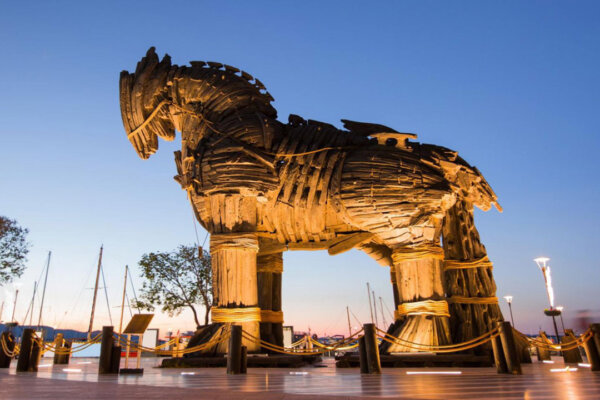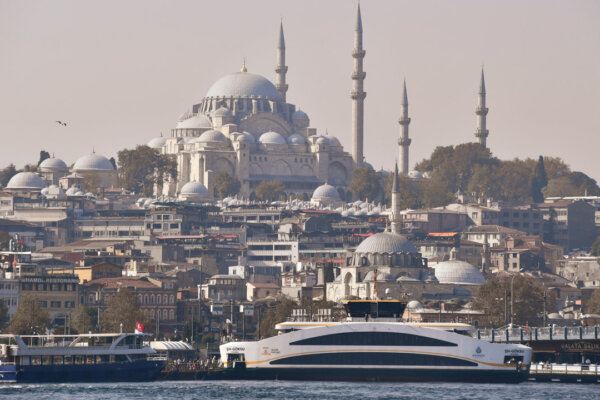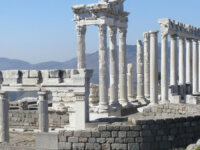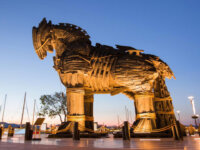Discover the grandeur of the Trajaneum, also known as the Temple of Trajan, nestled in the Upper Acropolis of Pergamon. This architectural masterpiece is a Roman monument that tells stories of imperial power and religious devotion.
In this article, we will delve into the history, construction process, and fascinating restoration of the Trajaneum, while unraveling the secrets of its enduring legacy.
The Trajaneum was built during the reign of Emperor Trajan in the 2nd century AD, as a symbol of his military victories and political achievements. It was designed by the famous architect Apollodorus of Damascus, who also worked on other iconic structures such as the Forum of Trajan and the Pantheon in Rome.
The temple was constructed using marble and adorned with intricate sculptures and reliefs, depicting scenes from Roman mythology and the emperor’s life. Its impressive size and elaborate design made it one of the most magnificent buildings in the ancient world.
However, the Trajaneum faced destruction over the centuries due to natural disasters and invasions. It was severely damaged by an earthquake in the 3rd century AD and later looted by the Goths in the 4th century. The temple was eventually abandoned and buried under layers of debris.
It wasn’t until the 19th century that the Trajaneum was rediscovered and excavated by German archaeologist Carl Humann. He uncovered the ruins of the temple and began the process of restoring it to its former glory.
Today, visitors can admire the impressive remains of the Trajaneum, including the grand entrance staircase, the main hall with its towering columns, and the altar where sacrifices were once made. The site also features a museum that displays artifacts found during the excavation, providing a deeper understanding of the temple’s significance.
The Trajaneum stands as a testament to the power and influence of the Roman Empire, as well as the enduring legacy of Emperor Trajan. Its majestic architecture and rich history continue to fascinate and inspire visitors from all over the world.
https://www.instagram.com/guia.turquia.ali/p/Bx4caciD6T2/
The connection with the Roman Empire of the province in Asia
The Trajaneum, commissioned by Emperor Trajan and completed during the reign of Hadrian, served as a symbolic link between the worship of the empire and the divine, connecting Pergamon to the grandeur of Rome.
As the fourth royal temple built in a province of Asia, the Trajaneum was constructed to proclaim the city’s loyalty to the Roman Empire, making a bold statement about its power and authority. It was also a testament to the cultural exchange and influence between Rome and the eastern regions of the empire.
The construction of the Trajaneum was a monumental undertaking, with its impressive size and intricate design showcasing the wealth and resources of Pergamon. The temple was dedicated to both Trajan and Zeus, further solidifying the connection between the imperial cult and the worship of the gods.
Not only did the Trajaneum serve as a religious center, but it also acted as a political symbol, representing the strong ties between Pergamon and Rome. It was a display of the city’s allegiance to the empire and its willingness to embrace Roman culture and customs.
Today, the ruins of the Trajaneum stand as a reminder of the once-great city of Pergamon and its significant role in the Roman Empire. Its architectural beauty and historical significance continue to fascinate and intrigue visitors, offering a glimpse into the past and the enduring legacy of the ancient world.
The downfall of a precious gemstone
During the Byzantine period, the walls of Trajaneum facing the valley were incorporated into the city’s fortifications and later repurposed as a water reservoir and storage facility. However, the value of its marble components skyrocketed, leading to widespread looting. By the end of the 19th century, the marble from the temple was reused for lime burning, leaving behind the magnificent facade that once stood. This unfortunate fate is not uncommon for ancient structures, as the demand for valuable materials often leads to their destruction. The Trajaneum serves as a reminder of the constant struggle between preserving history and satisfying present needs. Despite its current state, the remnants of this once grand temple continue to fascinate and intrigue visitors, offering a glimpse into the past glory of the Byzantine era.
Architectural Wonders
Located on top of the Acropolis, the Trajaneum is a remarkable feat of skilled engineering. Its rectangular foundation, intricately carved from white marble, required careful strategic planning on the rugged hillside.
The Roman engineers utilized parallel retaining walls with barrel vaults, maximizing the use of materials and overcoming challenges posed by the uneven terrain. This ingenious design allowed for the construction of a sturdy and stable structure, despite the difficult conditions.
The Trajaneum stands as a testament to the advanced engineering techniques of the ancient Romans. It not only showcases their mastery of architectural design, but also their ability to adapt and innovate in the face of challenging circumstances. The precision and attention to detail in its construction is a reflection of the high level of craftsmanship that was present during the Roman Empire.
Today, the Trajaneum remains a popular tourist attraction, drawing visitors from all over the world to marvel at its impressive architecture and learn about the rich history behind it. Its enduring presence serves as a reminder of the incredible achievements of the past and continues to inspire future generations.
Unique architectural features
With a length of 68 meters and a width of 58 meters, the rectangular base of Trajaneum stands tall as the highest point on the Acropolis. Adorned with Corinthian columns and unique architectural elements, the peripheral design of the temple features a row of columns surrounding the preserved area. A raised platform with statues of emperors reflects the Roman tradition of worshiping royalty.
https://www.instagram.com/p/Bz0kmKigvVq/
Rediscover and restore archaeology
In the late 19th century, architect H. Stiller discovered Trajaneum, but it wasn’t until the 1960s that Turkey began efforts to restore it. The German Archaeological Institute played a crucial role in this endeavor, utilizing analytical methods to meticulously reconstruct the temple down to every detail.
Completed in 1994, Trajaneum now stands as a testament to the collaborative efforts of archaeological research. This restoration project not only showcases the impressive skills and techniques used by ancient civilizations, but also highlights the importance of international cooperation in preserving and understanding our shared cultural heritage.
The Trajaneum, located in Pergamon, Turkey, was built during the reign of Emperor Trajan in the 2nd century AD. It served as a monumental temple dedicated to the Roman emperor and was considered one of the most magnificent structures of its time. However, over the centuries, the temple fell into disrepair and was eventually buried under layers of soil and debris.
Thanks to the discovery made by H. Stiller, the Trajaneum was brought back into the spotlight and efforts were made to restore it to its former glory. The German Archaeological Institute, with its expertise in excavation and preservation, took on the task of carefully uncovering and reconstructing the temple.
Using advanced techniques such as photogrammetry and laser scanning, the team was able to create accurate 3D models of the temple’s remains. These models were then used to guide the reconstruction process, ensuring that every detail was faithfully reproduced.
Today, the Trajaneum stands as a symbol of the successful collaboration between different countries and institutions in the field of archaeology. It serves as a reminder of the importance of preserving our past and learning from it, and also showcases the remarkable achievements of ancient civilizations in architecture and engineering.
Guide for tourists.
For those who wish to witness the magnificent beauty of Trajaneum, a visit to the Upper Acropolis of Pergamon is a must. The entrance fee to the ancient city walls is 25 TL (approximately 0,83 USD) and the site welcomes visitors from 8:30am to 6:30pm daily.
In addition, artifacts from this region are currently on display at the Bergama Archaeological Museum, while some grand sculptures can be found at the Pergamon Museum in Berlin. These museums offer a deeper understanding of the history and culture of Pergamon, allowing visitors to fully appreciate the significance of the Upper Acropolis.
The Upper Acropolis of Pergamon is a testament to the advanced engineering and architectural skills of the ancient Greeks. It was once a thriving city, known for its impressive structures and rich cultural heritage. Today, visitors can explore the ruins of the city walls, temples, and other important buildings, marveling at their intricate designs and grandeur.
One of the most notable structures on the Upper Acropolis is the Trajaneum, a temple dedicated to the Roman emperor Trajan. This impressive building was constructed in the 2nd century AD and served as a symbol of the city’s loyalty to the Roman Empire. Its grand columns and intricate friezes are a sight to behold, making it a popular attraction among tourists.
Aside from the Trajaneum, there are also other noteworthy structures on the Upper Acropolis such as the Altar of Zeus, the Temple of Athena, and the Library of Pergamon. Each of these structures holds its own historical and cultural significance, providing a glimpse into the past glory of Pergamon.
A visit to the Upper Acropolis of Pergamon not only offers a chance to admire the ancient architecture and artifacts, but also provides a unique opportunity to learn about the rich history and culture of this once-great city. So, for those who are planning a trip to Turkey, be sure to add Pergamon to your itinerary and experience the grandeur of the Upper Acropolis for yourself.
Conclusion.
The story of Trajaneum is one that speaks to the resilience, restoration, and impact of the Roman Empire. Standing atop the elevated land of Pergamon, one cannot help but be transported back in time by the echoes of ancient power and the dazzling architecture that surrounds them. It is a journey through the ages, where emperors and gods were revered on equal footing.
The Trajaneum, also known as the Temple of Trajan, was built during the reign of Emperor Trajan in the 2nd century AD. It was dedicated to the worship of both Trajan and Zeus, showcasing the fusion of Roman and Greek cultures that was prevalent during this time. The grand structure stood tall and proud, a symbol of the might and influence of the Roman Empire.
But like many ancient structures, the Trajaneum fell into ruin over time. It wasn’t until the 19th century that excavations began to uncover its remains, revealing the intricate details and craftsmanship that went into its construction. Through careful restoration efforts, the Trajaneum has been brought back to life, allowing visitors to marvel at its beauty and significance once again.
Today, the Trajaneum stands as a testament to the enduring legacy of the Roman Empire. It serves as a reminder of the power and ingenuity of those who came before us, and the impact they have had on our world. As we walk through its halls and admire its grandeur, we are transported back in time and given a glimpse into the rich history of the ancient world.




















